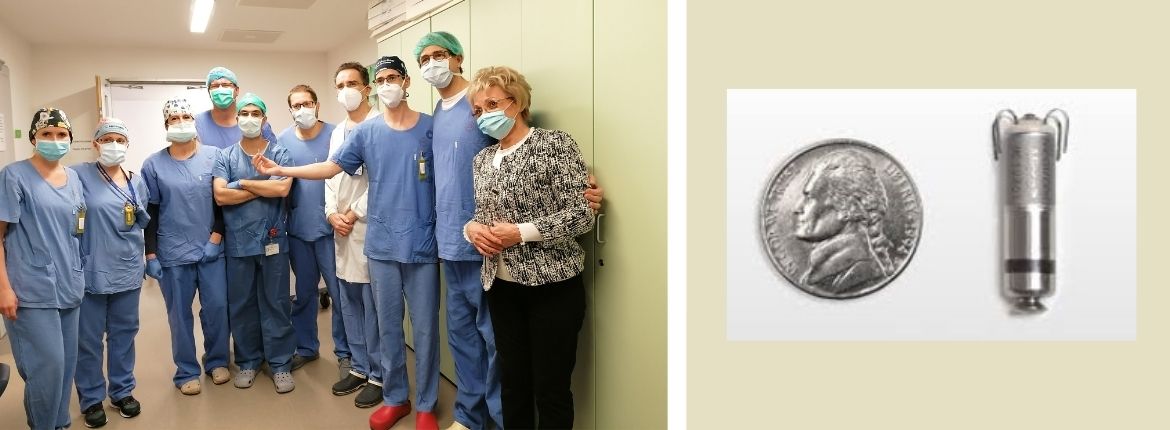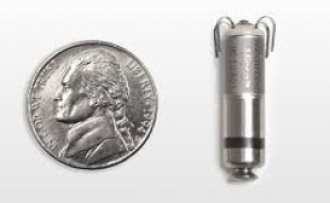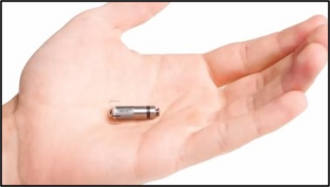
Last year in December the world’s smallest leadless pacemaker was implanted at the Albert Szent-Györgyi Health Center (SZTE SZAKK), Division of Electrophysiology, Department of Internal Medicine of the University of Szeged. Assistant professor Máté Vámos, M.D. Ph.D., who performed the procedure believes, that this expensive miniature device which now can only be implanted in exceptional cases, will be available for more candidate patients from 2021.
Outside Budapest this procedure was performed for the first time in Szeged. The leadless pacemaker is 90% smaller than the generally used transvenous pacemaker, and is a self-contained generator and electrode system implanted directly into the right ventricle. “We are proud to be able to implant the most advanced high-tech pacemaker system in case of exceptional cases in Szeged,” said Dr. Máté Vámos. He added that this new implantation technique poses a significant change when compared to the traditional pacemaker implantations. During the traditional method the heart-rate regulating device is implanted via surgical procedure. In this case the small device is being inserted into an under-the-skin (subcutaneous) pocket and the leads from the device go through the veins into the heart. In the new method, which is monitored by constant X-ray imaging the device is implanted using a femoral vein transcatheter. This procedure enables the insertion of the leadless, capsule-shaped device directly into the right ventricle.

The Capsule-Shaped Pacemaker is Invisible from the Outside
Although conventional pacing systems are safe, as time passes, occasionally the leads can get fractured or infected, and subcutaneous pocket infections can also occur. Leadless pacemakers were designed to eliminate these risks. In 2012 the miniature device, which weighs only 2 grams, was implanted for the first time in the world in the USA. In 2014 for the first time in East-Central Europe the procedure was performed at the Hungarian Military Hospital Medical Centre’s Department of Cardiology. The leadless pacemaker has benefits both medically and cosmetically. There are no leads in the heart, no chest incisions or a visible pacemaker pocket under the skin, so possible infections caused by artificial materials are minimalized, and there is no scar or visible bump on the chest under the skin as a result. This procedure leaves the patient only with a 2 cm (3/4 inch) scar on the anterior thigh region.

Life-Saving Surgery
Dr. Máté Vámos told us, that the first patient in Szeged selected for this exceptional procedure had multiple complications with their original traditional pacemaker. The leads of the conventional device got infected, along with a blockage in their superior vena cava, therefore the replacement with a similar device was not possible. The risks were also elevated for this individual, because the patient was going through haemodialysis due to kidney problems, which makes the body more prone to infections. . To implant the new leadless pacemaker, the old and infected pacing system had to be removed. At the University of Szeged, in the Division of Electrophysiology, Department of Internal Medicine, which is one of the major extraction centres in the country, lead extraction surgical procedures areperformed on a regular basis. László Sághy, M.D., assistant professor and department head, and Attila Benák M.D., a clinician extracted the infected leads and the device in a complex surgical procedure. Without the pacemaker, the patient’s heart would have stopped, but if the infected pacing system had stayed inside their body, it would have caused irreversible pericarditis (heart inflammation).
A New Opportunity for Patients
“Currently, in Hungary this leadless capsule-like pacemaker can only be implanted under special funding for patients in exceptional circumstances, just like this oneWith this financial help the patient was able to get the more expensive, millions of Forints worth pacemaker implanted instead of the transvenous pacing system” - said Dr. Máté Vámos, the Country Secretary of the Arrhythmia and Pacing Working Group of the Hungarian Society of Cardiology. He added, he’s hopeful that more procedures like this will be performed this year in Szeged.
“The Tasks of the National Health Insurance Fund of Hungary (NEAK) plans to place the leadless pacemaker’s accessibility from the category of special funding equity under exceptional circumstances to the category of funding for special devices. With this change of the funding categories new opportunities will emerge for patients who are in need,” - says the assistant professor. He explained that in Hungary there are close to 40 000 people living with pacing systems, and there are approximately 500 –600 transvenous pacemakers implanted in Szeged each year. The implantation of the leadless pacemaker, which is 90% smaller than a traditional transvenous pacemaker is a milestone in the history of the SZTE SZAKK, since this miniature device is a cutting-edge technology in the world’s professional pacing field.

